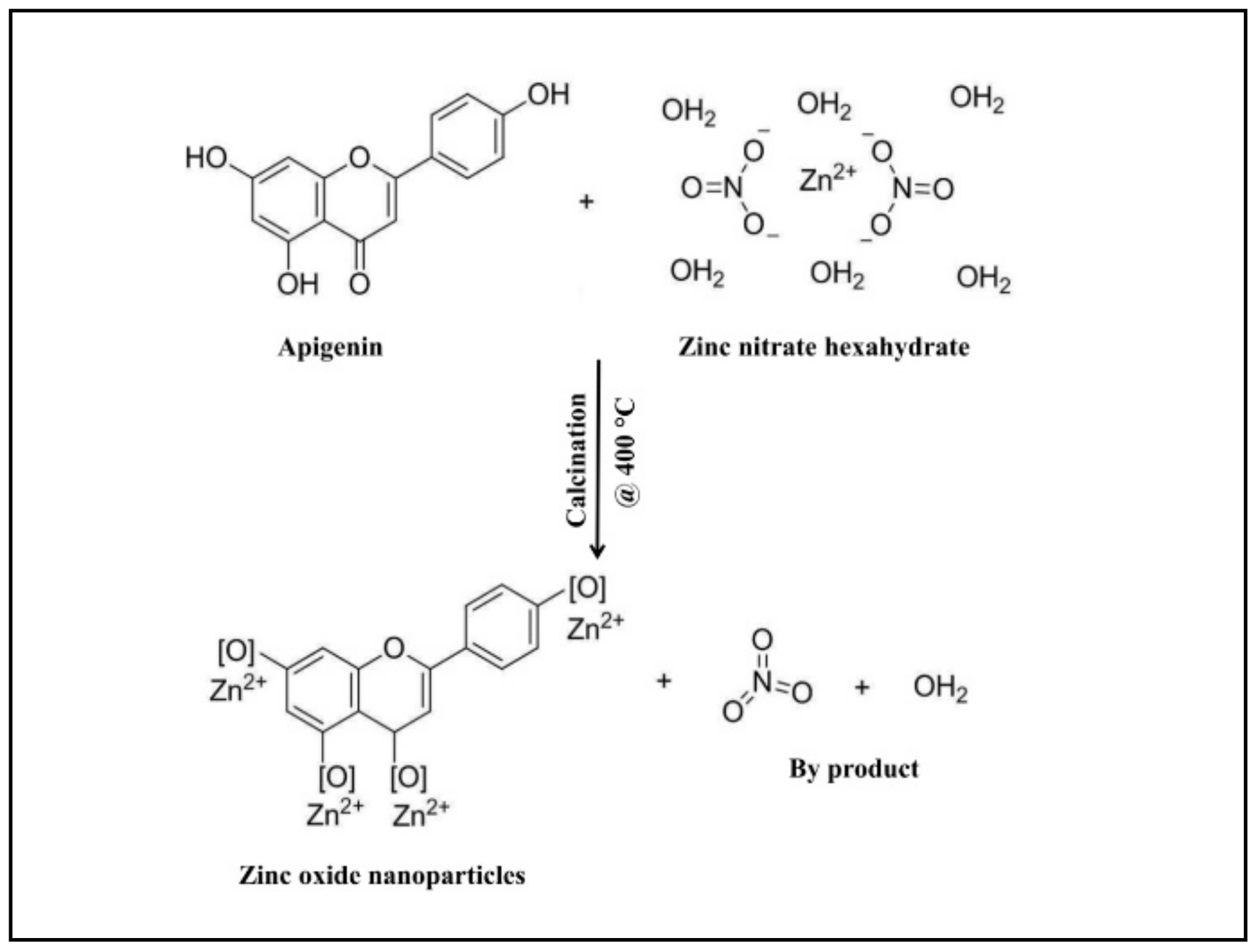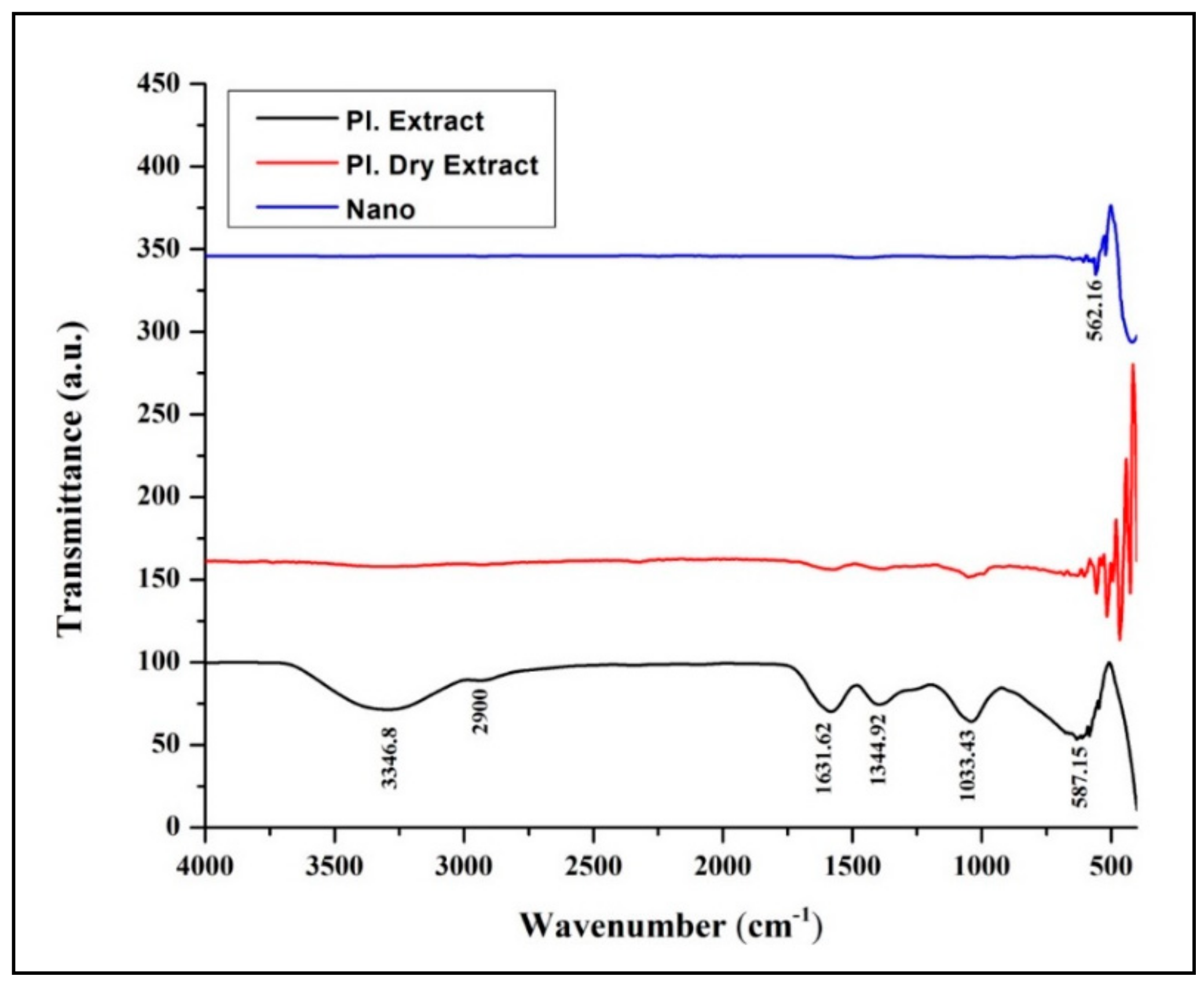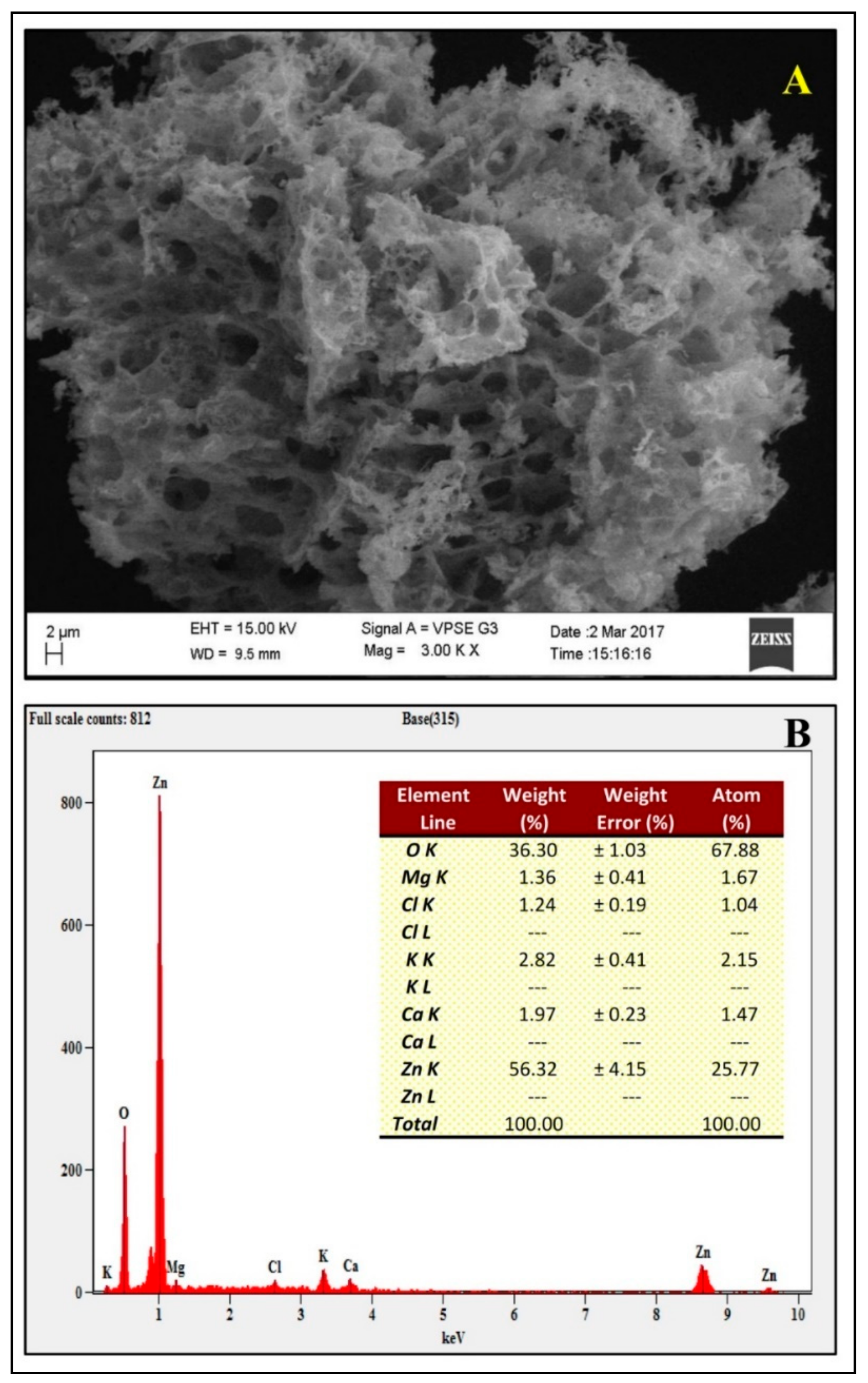Biosynthesized ZnO-NPs from Morus indica Attenuates Methylglyoxal-Induced Protein Glycation and RBC Damage: In-Vitro, In-Vivo and Molecular Docking Study
Abstract
1. Introduction
2. Materials and Methods
2.1. Collection of Plant
2.2. Chemicals
2.3. Biosynthesis of ZnO-NPs
2.4. Characterization of Biosynthesized ZnO-NPs
2.5. Effect of Biosynthesized ZnO-NPs from M. indica on Protein Glycation under In-Vitro
2.6. Effect of ZnO-NPs on the Formation of Amadori Product
Haemoglobin-δ-Gluconolactone (δ-Glu) Assay
2.7. Inhibitory Effect of ZnO-NPs on MGO Mediated Protein Glycation
2.7.1. Sample Preparation
2.7.2. Effect of ZnO-NPs on Inhibition of AGEs Formation
2.7.3. Protective Effect of ZnO-NPs on Red Blood Corpuscles
2.8. Inhibitory Effect of ZnO-NPs on N-Acetylglycyl-Lysine Methyl Ester (G.K.) Peptide Mediated Ribose Glycation
2.9. Effect of Biosynthesized ZnO-NPs from M. indica on Protein Glycation under In-Vivo
2.9.1. Experimental Animals
2.9.2. Incidence of Induction Streptozotocin of Diabetes and Treatment
2.9.3. Biochemical Studies
2.9.4. Histopathological Studies
2.10. Molecular Docking of BSA with ZnO-NPs and AG
2.11. Statistical Analysis
3. Results and Discussion
3.1. Characterization of Biosynthesized ZnO-NPs
3.2. Effect of ZnO-NPs on the Formation of Amadori Product
Hemoglobin-δ-Gluconolactone Assay
3.3. Inhibitory Effect of ZnO-NPs on MGO Mediated Protein Glycation
3.3.1. Effect of ZnO-NPs on Inhibition of AGEs Formation
3.3.2. Protective Effect of ZnO-NPs on Red Blood Corpuscles
3.4. Inhibitory Effect of ZnO-NPs on N-Acetylglycyl-Lysine Methyl Ester (G.K.) Peptide Mediated Ribose Glycation
3.5. To Assess the Potential of Biosynthesized ZnO-NPs from M. Indica as Protein Glycation Inhibitor in STZ-Induced Diabetic Rats
3.5.1. Biochemical Studies
3.5.2. Histopathological Studies
3.5.3. Molecular Docking of BSA with ZnO-NPs and AG
4. Conclusions
Supplementary Materials
Author Contributions
Funding
Acknowledgments
Conflicts of Interest
References
- Finot, P.A. Historical perspective of the Maillard reaction in food science. Ann. N. Y. Acad. Sci. 2005, 1043, 1–8. [Google Scholar] [CrossRef] [PubMed]
- Johnstonemd, M.T.; Kinzfogl, G.P. Diabetes mellitus and heart disease. In Diabetes and Cardiovascular Disease; Humana Press: Totowa, NJ, USA, 2005; pp. 579–628. [Google Scholar]
- Monnier, V.M. Nonenzymatic glycosylation, the Maillard reaction and the aging process. J. Gerontol. 1990, 45, 105–111. [Google Scholar] [CrossRef] [PubMed]
- Shubha, M.; D’Souza, C.J. Abnormal glucose metabolism in diabetes mellitus: Formation of advanced glycation end products and their consequences. My Science 2012, 7, 42–50. [Google Scholar]
- Singh, V.P.; Bali, A.; Singh, N.; Jaggi, A.S. Advanced glycation end products and diabetic complications. Korean J. Physiol. Pharm. 2014, 1, 1–14. [Google Scholar] [CrossRef] [PubMed]
- Bourdon, E.; Loreau, N.; Blache, D. Glucose and free radicals impair the antioxidant properties of serum albumin. FASEB J. 1999, 13, 233–244. [Google Scholar] [CrossRef]
- Prasanna, G.; Saraswathi, N. Aspartic acid functions as carbonyl trapper to inhibit the formation of advanced glycation end products by chemical chaperone activity. J. Biomol. Struct. Dyn. 2016, 34, 943–951. [Google Scholar] [CrossRef]
- Thornalley, P.J. Use of aminoguanidine (Pimagedine) to prevent the formation of advanced glycation endproducts. Arch. Biochem. Biophys. 2003, 419, 31–40. [Google Scholar] [CrossRef]
- Metz, T.O.; Alderson, N.L.; Chachich, M.E.; Thorpe, S.R.; Baynes, J.W. Pyridoxamine traps intermediates in lipid peroxidation reactions in vivo evidence on the role of lipids in chemical modification of protein and development of diabetic complications. J. Biol. Chem. 2003, 278, 42012–42019. [Google Scholar] [CrossRef]
- Webster, J.; Urban, C.; Berbaum, K.; Loske, C.; Alpar, A.; Gartner, U.; De Arriba, S.G.; Arendt, T.; Munch, G. The carbonyl scavengers aminoguanidine and tenilsetam protect against the neurotoxic effects of methylglyoxal. Neurotox. Res. 2005, 7, 95–101. [Google Scholar] [CrossRef]
- Beisswenger, P.; Ruggiero-Lopez, D. Metformin inhibition of glycation processes. Diabetes Metab. 2003, 29, 6S95–6S103. [Google Scholar] [CrossRef]
- Reddy, V.P.; Beyaz, A. Inhibitors of the Maillard reaction and AGE breakers as therapeutics for multiple diseases. Drug Discov. Today 2006, 11, 646–654. [Google Scholar] [CrossRef] [PubMed]
- Bolton, W.K.; Cattran, D.C.; Williams, M.E.; Adler, S.G.; Appel, G.B.; Cartwright, K.; Foiles, P.G.; Freedman, B.I.; Raskin, P.; Ratner, R.E.; et al. Randomized trial of an inhibitor of formation of advanced glycation end products in diabetic nephropathy. Am. J. Nephrol. 2004, 24, 32–40. [Google Scholar] [CrossRef] [PubMed]
- Jain, K.K. Nanotechnology in clinical laboratory diagnostics. Clin. Chim. Acta 2005, 358, 37–54. [Google Scholar] [CrossRef] [PubMed]
- Lakshmeesha, T.R.; Sateesh, M.K.; Prasad, B.D.; Sharma, S.C.; Kavyashree, D.; Chandrasekhar, M.; Nagabhushana, H. Reactivity of crystalline ZnO superstructures against fungi and bacterial pathogens: Synthesized using Nerium oleander leaf extract. Cryst. Growth Des. 2014, 14, 4068–4079. [Google Scholar] [CrossRef]
- Ashraf, J.M.; Ansari, M.A.; Khan, H.M.; Alzohairy, M.A.; Choi, I. Green synthesis of silver nanoparticles and characterization of their inhibitory effects on AGEs formation using biophysical techniques. Sci. Rep. 2016, 6, 20414. [Google Scholar] [CrossRef]
- Liu, W.; Cohenford, M.A.; Frost, L.; Seneviratne, C.; Dain, J.A. Inhibitory effect of gold nanoparticles on the d-ribose glycation of bovine serum albumin. Int. J. Nanomed. 2014, 9, 5461. [Google Scholar] [CrossRef]
- Yu, S.; Zhang, W.; Liu, W.; Zhu, W.; Guo, R.; Wang, Y.; Zhang, D.; Wang, J. The inhibitory effect of selenium nanoparticles on protein glycation in vitro. Nanotechnology 2015, 26, 145703. [Google Scholar] [CrossRef]
- Zhou, Y.; Li, L.; Li, S.; Zhao, M.; Zhou, Q.; Gong, X.; Yang, J.; Chang, J. Autoregenerative redox nanoparticles as an antioxidant and glycation inhibitor for palliation of diabetic cataracts. Nanoscale 2019, 11, 13126–13138. [Google Scholar] [CrossRef]
- Urooj, A.; Ahmed, F. Ficus racemosa and Morus indica: Emerging alternative antihyperglycemic agents. Open Conf. Proc. J. 2013, 4, 59–65. [Google Scholar]
- Anandan, S.; Kotebagilu, N.P.; Shivanna, L.M.; Urooj, A. Inhibitory potency of C-glycosyl flavonoids from Morus sp. on advanced glycation end products. J. Biol. Act. Prod. Nat. 2017, 7, 391–400. [Google Scholar] [CrossRef]
- Murali, M.; Mahendra, C.; Rajashekar, N.; Sudarshana, M.S.; Raveesha, K.A.; Amruthesh, K.N. Antibacterial and antioxidant properties of biosynthesized zinc oxide nanoparticles from Ceropegia candelabrum L.—An endemic species. Spectrochim. Acta A 2017, 15, 104–109. [Google Scholar] [CrossRef]
- Ashraf, J.M.; Ansari, M.A.; Fatma, S.; Abdullah, S.M.; Iqbal, J.; Madkhali, A.; Hamali, A.H.; Ahmad, S.; Jerah, A.; Echeverria, V.; et al. Inhibiting effect of zinc oxide nanoparticles on advanced glycation products and oxidative modifications: A potential tool to counteract oxidative stress in neurodegenerative diseases. Mol. Neurobiol. 2018, 55, 7438–7452. [Google Scholar] [CrossRef] [PubMed]
- Jalal, M.; Ansari, M.A.; Ali, S.G.; Khan, H.M.; Rehman, S. Anticandidal activity of bioinspired ZnO NPs: Effect on growth, cell morphology and key virulence attributes of Candida species. Artif. Cells Nanomed. Biotechnol. 2018, 46, 912–925. [Google Scholar] [CrossRef] [PubMed]
- Losso, J.N.; Bawadi, H.A.; Chintalapati, M. Inhibition of the formation of advanced glycation end products by thymoquinone. Food Chem. 2011, 128, 55–61. [Google Scholar] [CrossRef] [PubMed]
- Swamy-Mruthinti, S.; Green, K.; Abraham, E.C. Inhibition of cataracts in moderately diabetic rats by aminoguanidine. Exp. Eye Res. 1996, 62, 505–510. [Google Scholar] [CrossRef]
- Ansari, M.A.; Khan, H.M.; Khan, A.A.; Alzohairy, M.A. Biochemical and histopathological ultrastructural changes caused by ZnO nanoparticles in mice. Toxicol. Environ. Chem. 2015, 97, 1025–1040. [Google Scholar] [CrossRef]
- Ledesma, A.E.; Chemes, D.M.; Angeles Frías, M.; Torres, M.D.P.G. Spectroscopic characterization and docking studies of ZnO nanoparticle modified with BSA. Appl. Surf. Sci. 2017, 412, 177–188. [Google Scholar] [CrossRef]
- Frisch, M.J.; Trucks, G.W.; Schlegel, H.B.; Scuseria, G.E.; Robb, M.A.; Cheeseman, J.R.; Scalmani, G.; Barone, V.; Mennucci, B.; Petersson, G.A.; et al. Gaussian 09, Revision E.01; Gaussian, Inc.: Pittsburgh, PA, USA, 2009. [Google Scholar]
- Morris, G.M.; Huey, R.; Lindstrom, W.; Sanner, M.F.; Belew, R.K.; Goodsell, D.S.; Olson, A.J. AutoDock4 and AutoDockTools4: Automated docking with selective receptor flexibility. J. Comput. Chem. 2009, 30, 2785–2791. [Google Scholar] [CrossRef]
- Medina-Ramirez, I.; Bashir, S.; Luo, Z.; Liu, J.L. Green synthesis and characterization of polymer-stabilized silver nanoparticles. Colloids Surf. B Biointerfaces 2009, 73, 185–191. [Google Scholar] [CrossRef]
- Jha, A.K.; Prasad, K. Green synthesis of silver nanoparticles using Cycas leaf. Int. J. Green Nanotechnol. Phys. Chem. 2010, 1, P110–P117. [Google Scholar] [CrossRef]
- Yuvakkumar, R.; Suresh, J.; Nathanael, A.J.; Sundrarajan, M.; Hong, S.I. Novel green synthetic strategy to prepare ZnO nanocrystals using rambutan (Nephelium lappaceum L.) peel extract and its antibacterial applications. Mater. Sci. Eng. C 2014, 41, 17–27. [Google Scholar] [CrossRef] [PubMed]
- Karnan, T.; Selvakumar, S.A.S. Biosynthesis of ZnO nanoparticles using rambutan (Nephelium lappaceum L.) peel extract and their photocatalytic activity on methyl orange dye. J. Mol. Struct. 2016, 1125, 358–365. [Google Scholar] [CrossRef]
- Jafarirad, S.; Mehrabi, M.; Divband, B.; Kosari-Nasab, M. Biofabrication of zinc oxide nanoparticles using fruit extract of Rosa canina and their toxic potential against bacteria: A mechanistic approach. Mater. Sci. Eng. C Mater. Biol. Appl. 2016, 59, 296–302. [Google Scholar] [CrossRef] [PubMed]
- Kisi, E.H.; Elcombe, M.M. U parameters for the wurtzite structure of ZnS and ZnO using powder neutron diffraction. Acta Cryst. C 1989, 45, 1867–1870. [Google Scholar] [CrossRef]
- Senthilkumar, S.; Sivakumar, T. Green tea (Camellia sinensis) mediated synthesis of zinc oxide (ZnO) nanoparticles and studies on their antimicrobial activities. Int. J. Pharm. Pharm. Sci. 2014, 6, 461–465. [Google Scholar]
- Mahendra, C.; Murali, M.; Manasa, G.; Ponnamma, P.; Abhilash, M.R.; Lakshmeesha, T.R.; Satish, A.; Amruthesh, K.N.; Sudarshana, M.S. Antibacterial and antimitotic potential of bio-fabricated zinc oxide nanoparticles of Cochlospermum religiosum (L.). Microb. Pathog. 2017, 110, 620–629. [Google Scholar] [CrossRef] [PubMed]
- Kumar, N.K.; Murali, M.; Satish, A.; Singh, S.B.; Gowtham, H.G.; Mahesh, H.M.; Lakshmeesha, T.R.; Amruthesh, K.N.; Jagannath, S. Bioactive and biocompatible nature of green synthesized zinc oxide nanoparticles from Simarouba glauca DC.: An endemic plant to western Ghats, India. J. Cluster Sci. 2019, 1–12. [Google Scholar] [CrossRef]
- Yuvakkumar, R.; Suresh, J.; Saravanakumar, B.; Nathanael, A.J.; Hong, S.I.; Rajendran, V. Rambutan peels promoted biomimetic synthesis of bioinspired zinc oxide nanochains for biomedical applications. Spectrochim. Acta A 2015, 25, 250–258. [Google Scholar] [CrossRef]
- Kumar, S.S.; Venkateswarlu, P.; Rao, V.R.; Rao, G.N. Synthesis, characterization and optical properties of zinc oxide nanoparticles. Int. Nano Lett. 2013, 3, 30. [Google Scholar] [CrossRef]
- Dobrucka, R.; Długaszewska, J. Biosynthesis and antibacterial activity of ZnO nanoparticles using Trifolium pratense flower extract. Saudi J. Biol. Sci. 2016, 23, 517–523. [Google Scholar] [CrossRef]
- Westwood, M.E.; McLellan, A.C.; Thornalley, P.J. Receptor-mediated endocytic uptake of methylglyoxal-modified serum albumin. Competition with advanced glycation end product-modified serum albumin at the advanced glycation end product receptor. J. Biol. Chem. 1994, 269, 32293–32298. [Google Scholar] [PubMed]
- Morimitsu, Y.; Yoshida, K.; Esaki, S.; Hirota, A. Protein glycation inhibitors from thyme (Thymus vulgaris). Biosci. Biotechnol. Biochem. 1995, 59, 2018–2021. [Google Scholar] [CrossRef] [PubMed]
- Uchida, K.; Kanematsu, M.; Sakai, K.; Matsuda, T.; Hattori, N.; Mizuno, Y.; Suzuki, D.; Miyata, T.; Noguchi, N.; Niki, E.; et al. Protein-bound acrolein: Potential markers for oxidative stress. Proc. Natl. Acad. Sci. USA 1998, 95, 4882–4887. [Google Scholar] [CrossRef] [PubMed]
- Awasthi, S.; Ravi, A.; Saraswathi, N. Troxerutin imparts preservative effects on albumin by preventing Maillard reaction-mediated early and advanced glycation modification. J. Biomol. Struct. Dyn. 2017, 35, 2681–2687. [Google Scholar] [CrossRef]
- Stadtman, E.R. Metal ion-catalyzed oxidation of proteins: Biochemical mechanism and biological consequences. Free Radic. Biol. Med. 1990, 9, 315–325. [Google Scholar] [CrossRef]
- Girish, T.K.; Prasada Rao, U.J. Protein glycation and aggregation inhibitory potency of biomolecules from black gram milled by-product. J. Sci. Food Agric. 2016, 96, 4973–4983. [Google Scholar] [CrossRef]
- Nemet, I.; Varga-Defterdarovic, L.; Turk, Z. Methylglyoxal in food and living organisms. Mol. Nutr. Food Res. 2006, 50, 1105–1117. [Google Scholar] [CrossRef]
- Peppa, M.; Uribarri, J.; Vlassara, H. Glucose, advanced glycation end products, and diabetes complications: What is new and what works. Clin. Diabetes 2003, 21, 186–187. [Google Scholar] [CrossRef]
- Nagaraj, R.H.; Shipanova, I.N.; Faust, F.M. Protein cross-linking by the Maillard reaction. Isolation, characterization, and in vivo detection of a lysine-lysine cross-link derived from methylglyoxal. J. Biol. Chem. 1996, 271, 19338–19345. [Google Scholar] [CrossRef]
- Rahbar, S.; Yerneni, K.K.; Scott, S.; Gonzales, N.; Lalezari, I. Novel inhibitors of advanced glycation endproducts (part II). Mol. Cell Biol. Res. Commun. 2000, 3, 360–366. [Google Scholar] [CrossRef]
- Wang, Y.J.; Xie, X.S.; Feng, S.G.; Long, Q.X.; Ai, N.; Wang, B.F. Causes of death in STZ-induced rat models of diabetes mellitus. Sichuan Da Xue Xue Bao Yi Xue Ban 2014, 45, 691–695. [Google Scholar] [PubMed]
- Rathinam, A.; Pari, L.; Chandramohan, R.; Sheikh, B.A. Histopathological findings of the pancreas, liver, and carbohydrate metabolizing enzymes in STZ-induced diabetic rats improved by administration of myrtenal. J. Physiol. Biochem. 2014, 70, 935–946. [Google Scholar] [CrossRef] [PubMed]
- Jain, D.; Saha, S. Antioxidant and antihyperglycaemic effects of naringenin arrest the progression of diabetic nephropathy in diabetic rats. Egypt Pharm. J. 2017, 16, 144–151. [Google Scholar] [CrossRef]
- Hostetter, T.H. Hypertrophy and hyperfunction of the diabetic kidney. J. Clin. Investig. 2001, 107, 161–162. [Google Scholar] [CrossRef][Green Version]
- Al-Quraishy, S.; Dkhil, M.A.; Moneim, A.E.A. Anti-hyperglycemic activity of selenium nanoparticles in streptozotocin-induced diabetic rats. Int. J. Nanomed. 2015, 10, 6741. [Google Scholar]
- Joglekar, M.M.; Panaskar, S.N.; Chougale, A.D.; Kulkarni, M.J.; Arvindekar, A.U. A novel mechanism for antiglycative action of limonene through stabilization of protein conformation. Mol. Biosyst. 2013, 9, 2463–2472. [Google Scholar] [CrossRef]
- Awasthi, S.; Saraswathi, N.T. Non-enzymatic glycation mediated structure-function changes in proteins: Case of serum albumin. RSC Adv. 2016, 6, 90739–90753. [Google Scholar] [CrossRef]









| RATS | Biochemical Analysis of Blood Serum | ||||||||||
|---|---|---|---|---|---|---|---|---|---|---|---|
| ALT (U L−1) | AST (U L−1) | ALP (U L−1) | CRE (MG DL−1) | BUN (MG DL−1) | ALB (G DL−1) | TP (G DL−1) | BIL (MG DL−1) | TG (MG DL−1) | TC (MG DL−1) | HDL (MG DL−1) | |
| Group 1 | 86.29 ± 2.90 | 263.51 ± 5.85 | 243.06 ± 22.71 | 0.74 ± 0.045 | 19.38 ± 1.02 | 3.52 ± 0.30 | 7.35 ± 0.41 | 0.26 ± 0.03 | 48.53 ± 2.07 | 55.90 ± 2.14 | 48.53 ± 2.07 |
| Group 2 | 197.62 ± 6.44 *,a | 477.11 ± 4.99 *,a | 823.86 ± 9.56 *,a | 0.96 ± 0.31 *,a | 51.50 ± 2.62 *,a | 1.37 ± 0.24 *,a | 4.75 ± 0.29 *,a | 0.38 ± 0.01 *,a | 143.81 ± 3.44 *,a | 77.28 ± 2.85 *,a | 38.41 ± 1.17 *,a |
| Group 3 | 110.90 ± 3.03 | 275.68 ± 5.42 | 276.47 ± 7.80 | 0.75 ± 0.035 b | 23.676 ± 1.4 b | 2.97 ± 0.17 b | 6.73 ± 0.39b | 0.22 ± 0.03 b | 59.21 ± 1.44 | 58.10 ± 1.27 b | 44.50 ± 1.52 b |
| Group 4 | 125.65 ± 3.08 | 321.80 ± 5.34 | 532.87 ± 8.56 | 0.74 ± 0.02 b | 22.06 ± 1.48 b | 2.78 ± 0.13 b | 6.24 ± 0.13 b | 0.21 ± 0.02 b | 96.84 ± 1.92 | 57.39 ± 1.87 b | 46.88 ± 1.18 b |
© 2019 by the authors. Licensee MDPI, Basel, Switzerland. This article is an open access article distributed under the terms and conditions of the Creative Commons Attribution (CC BY) license (http://creativecommons.org/licenses/by/4.0/).
Share and Cite
Anandan, S.; Mahadevamurthy, M.; Ansari, M.A.; Alzohairy, M.A.; Alomary, M.N.; Farha Siraj, S.; Halugudde Nagaraja, S.; Chikkamadaiah, M.; Thimappa Ramachandrappa, L.; Naguvanahalli Krishnappa, H.K.; et al. Biosynthesized ZnO-NPs from Morus indica Attenuates Methylglyoxal-Induced Protein Glycation and RBC Damage: In-Vitro, In-Vivo and Molecular Docking Study. Biomolecules 2019, 9, 882. https://doi.org/10.3390/biom9120882
Anandan S, Mahadevamurthy M, Ansari MA, Alzohairy MA, Alomary MN, Farha Siraj S, Halugudde Nagaraja S, Chikkamadaiah M, Thimappa Ramachandrappa L, Naguvanahalli Krishnappa HK, et al. Biosynthesized ZnO-NPs from Morus indica Attenuates Methylglyoxal-Induced Protein Glycation and RBC Damage: In-Vitro, In-Vivo and Molecular Docking Study. Biomolecules. 2019; 9(12):882. https://doi.org/10.3390/biom9120882
Chicago/Turabian StyleAnandan, Satish, Murali Mahadevamurthy, Mohammad Azam Ansari, Mohammad A. Alzohairy, Mohammad N. Alomary, Syeda Farha Siraj, Sarjan Halugudde Nagaraja, Mahendra Chikkamadaiah, Lakshmeesha Thimappa Ramachandrappa, Hemanth Kumar Naguvanahalli Krishnappa, and et al. 2019. "Biosynthesized ZnO-NPs from Morus indica Attenuates Methylglyoxal-Induced Protein Glycation and RBC Damage: In-Vitro, In-Vivo and Molecular Docking Study" Biomolecules 9, no. 12: 882. https://doi.org/10.3390/biom9120882
APA StyleAnandan, S., Mahadevamurthy, M., Ansari, M. A., Alzohairy, M. A., Alomary, M. N., Farha Siraj, S., Halugudde Nagaraja, S., Chikkamadaiah, M., Thimappa Ramachandrappa, L., Naguvanahalli Krishnappa, H. K., Ledesma, A. E., Nagaraj, A. K., & Urooj, A. (2019). Biosynthesized ZnO-NPs from Morus indica Attenuates Methylglyoxal-Induced Protein Glycation and RBC Damage: In-Vitro, In-Vivo and Molecular Docking Study. Biomolecules, 9(12), 882. https://doi.org/10.3390/biom9120882







